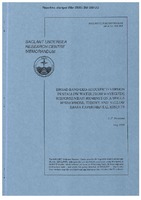| dc.contributor.author | Hermand, Jean-Pierre | |
| dc.date.accessioned | 2018-10-11T14:08:56Z | |
| dc.date.available | 2018-10-11T14:08:56Z | |
| dc.date.issued | 1999/05 | |
| dc.identifier | 12242 | |
| dc.identifier.govdoc | SM-359 | |
| dc.identifier.uri | http://hdl.handle.net/20.500.12489/536 | |
| dc.description.abstract | Executive summary: Performance models such as the Allied Environmental Support System (AESS) require environmental input parameters such as the geoacoustic properties of the battlespace. The models ingest the input parameters from databases to predict the ASW and MCM performance in the operating area. These databases have a scarcity of data, particularly in littoral environments. A Rapid Environmental Assessment (REA) technique has been devleoped which allows for the determination of the geoacoustic properties without resorting to large acoustic receiving apertures. The method is based on reception of broadband acoustic signals and modelling the littoral environment between the acoustic transmitter and a signal receiving hydrophone. In addition, the technique has been extended to drifting sonobuoys such that the bottom properties of the battlespace can be determined remotely. This report presents the measurement and modelling results and demonstrates that the bottom features can be resolved. | |
| dc.format | vi, 63, 26 p. : ill. | |
| dc.language | English | |
| dc.publisher | NATO. SACLANTCEN | |
| dc.subject | Geoacoustic inversion | |
| dc.subject | Shallow water | |
| dc.subject | Rapid Environmental Assessment (REA) | |
| dc.title | Broad-band geoacoustic inversion in shallow water from waveguide response measurements on a single hydrophone: theory and YELLOW SHARK experimental results | |
| dc.type | Scientific Memorandum (SM) | |
